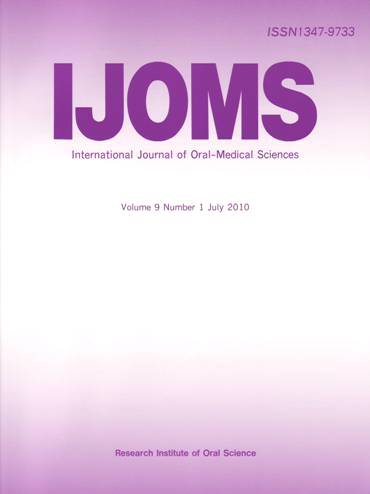Volume 9, Issue 3
Displaying 1-14 of 14 articles from this issue
- |<
- <
- 1
- >
- >|
Original Articles
-
2011Volume 9Issue 3 Pages 159-166
Published: 2011
Released on J-STAGE: May 11, 2011
Download PDF (453K) -
2011Volume 9Issue 3 Pages 167-174
Published: 2011
Released on J-STAGE: May 11, 2011
Download PDF (554K) -
2011Volume 9Issue 3 Pages 175-181
Published: 2011
Released on J-STAGE: May 11, 2011
Download PDF (186K) -
2011Volume 9Issue 3 Pages 182-189
Published: 2011
Released on J-STAGE: May 11, 2011
Download PDF (314K) -
2011Volume 9Issue 3 Pages 190-196
Published: 2011
Released on J-STAGE: May 11, 2011
Download PDF (753K) -
2011Volume 9Issue 3 Pages 197-205
Published: 2011
Released on J-STAGE: May 11, 2011
Download PDF (258K) -
2011Volume 9Issue 3 Pages 206-212
Published: 2011
Released on J-STAGE: May 11, 2011
Download PDF (202K) -
2011Volume 9Issue 3 Pages 213-219
Published: 2011
Released on J-STAGE: May 11, 2011
Download PDF (190K) -
2011Volume 9Issue 3 Pages 220-226
Published: 2011
Released on J-STAGE: May 11, 2011
Download PDF (206K) -
2011Volume 9Issue 3 Pages 227-233
Published: 2011
Released on J-STAGE: May 11, 2011
Download PDF (337K) -
2011Volume 9Issue 3 Pages 234-240
Published: 2011
Released on J-STAGE: May 11, 2011
Download PDF (275K) -
2011Volume 9Issue 3 Pages 241-251
Published: 2011
Released on J-STAGE: May 11, 2011
Download PDF (406K)
Case Reports
-
2011Volume 9Issue 3 Pages 252-258
Published: 2011
Released on J-STAGE: May 11, 2011
Download PDF (308K)
Erratum
-
2010Volume 9Issue 3 Pages 260
Published: 2010
Released on J-STAGE: May 11, 2011
Download PDF (25K)
- |<
- <
- 1
- >
- >|
